Look no further than rasboras, if you are seek to add a touch of vibrant beauty and tranquility as you watch the rasboras uniform schooling behavior!
The stunning freshwater fish that have become a popular choice among aquarists worldwide. In this list of the different types of rasboras, we delve into the fascinating world of these tiny fish, shedding light on their unique characteristics, care requirements, and ideal tank setups.
Rasboras, belonging to the family Cyprinidae, encompass a diverse range of over 100 species, each boasting its own captivating allure.
From the breathtaking colors of the Harlequin Rasbora to the mesmerizing patterns of the Scissortail Rasbora, these small, peaceful fish have a way of captivating the imagination of aquarists.
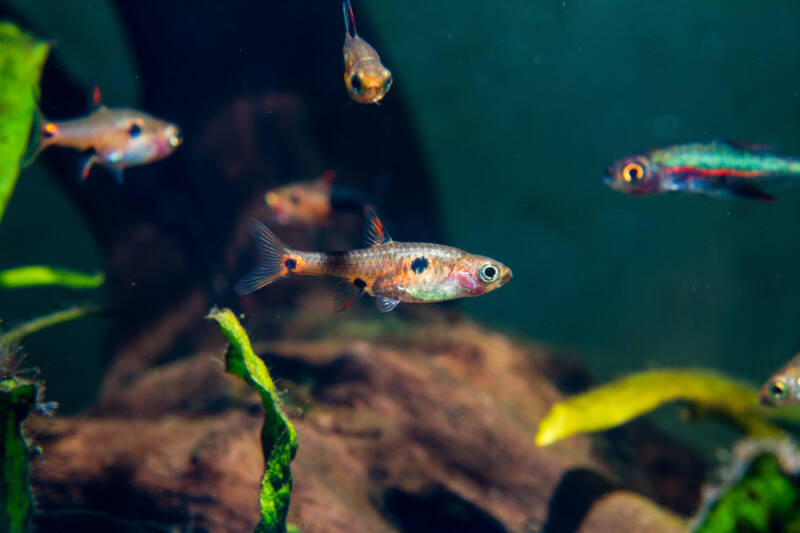
Rasboras are native to Southern and Southeastern Asia, preferring shallow waters with abundant plants. The overgrown waters make for dim lighting, and the decaying plant material stains the water with tannins.
[toc]
Types of Rasboras
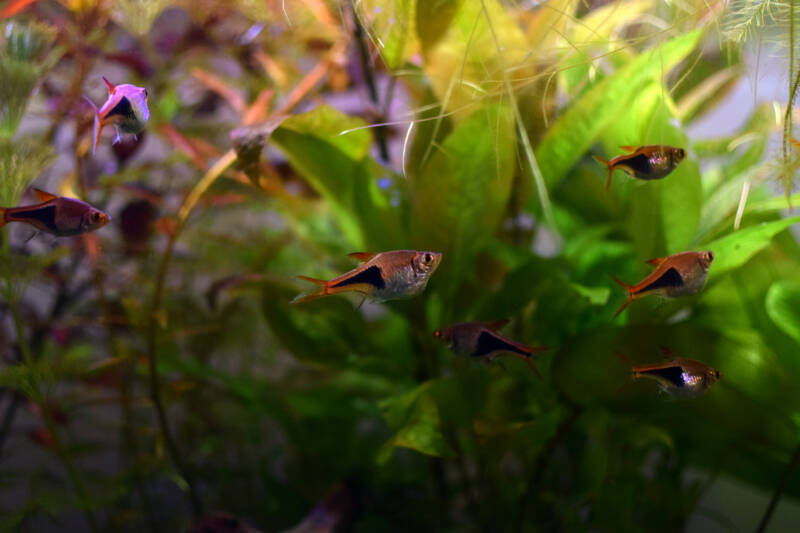
As more and more study goes into rasboras, new types may begin to emerge. For now, you can find a wide variety of colors, patterns, and even body shapes.
1. Blackline Rasbora (Rasbora borapetensis)

- Difficulty: Easy
- Size: 2.5 inches
- Temperament: Peaceful
- Diet: Carnivore
- Tank Size: 15 gal (57 l)
You may find blackline rasboras listed under the name “red-tailed rasboras.” In addition to the sleek black line bisecting their bodies, they have a splash of red at the base of their tails. Since a black stripe down the middle occurs on several types of rasboras, that red spot’s more distinctive.
Blacklines fit the bill when it comes to hardy freshwater fish. In the wild, you often find them in polluted water sources. This makes them a little more tolerant of water quality changes when they enter the aquarium world (not that that’s an excuse for poor management).
These little fish are happiest in groups of at least eight. You’ll want to scale the size of your tank up appropriately. You’ll end up with calmer fish in a larger school.
If you choose a balance between males and females, they’ll show their colors to the best effect.
2. Sidestripe Rasbora (Rasbora paviana)
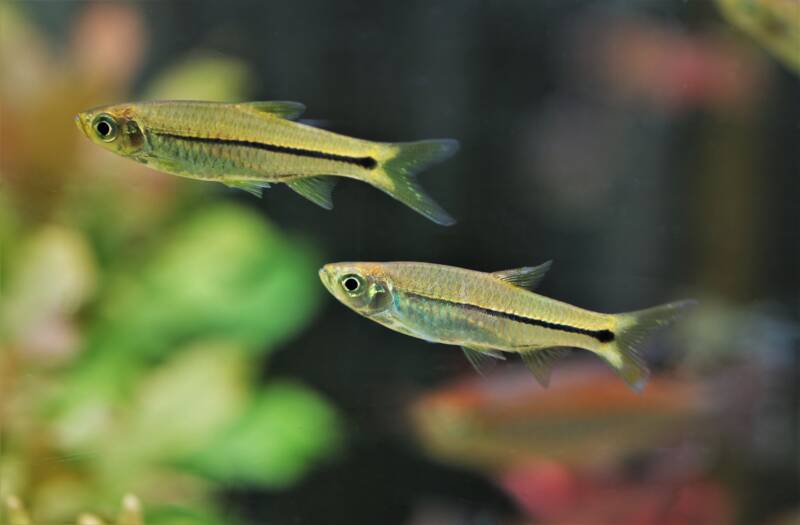
- Difficulty: Easy
- Size: 3.5 inches
- Temperament: Peaceful
- Diet: Omnivore
- Tank Size: 30 gal (114 l)
Sidestripe rasboras have shimmering silver bodies with a distinct, solid line running the length. This stripe terminates in an irregular spot, resembling an exclamation mark.
These fish reach 3.5 inches (9 cm) in length. Their behavior, when schooling in groups of at least six, makes them excellent community tank members.
This Asian native lives in shallow canals, rivers, and streams where they favor the middle to upper levels of the water column. They are hardy and inhabit a range of environments, including swift and slow-moving waters.
Sidestripes are omnivores that need high levels of meaty foods in their diet to exhibit their brightest colors.
3. Brilliant Rasbora (Rasbora einthovenii)
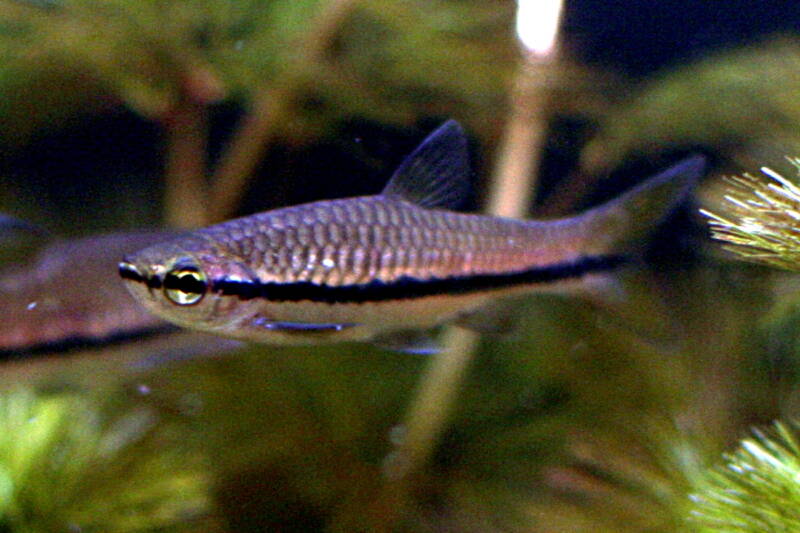
- Difficulty: Easy-Moderate
- Size: 3.6 inches
- Temperament: Peaceful
- Diet: Carnivore
- Tank Size: 30 gal (114 l)
Brilliant rasboras have that same black line down their sides as blackline rasboras. However, the iridescence of their scales is much more prominent. They have a shiny silver that makes them stand out a little more and grants them their name.
Brilliants are among the larger types of rasboras, reaching an adult length of 3.6 inches (9 cm). As they prefer a school of at least six to stave off nervous behavior, that translates to an aquarium on a grander scale.
Brilliant rasboras don’t make frequent appearances in the aquarium trade. Most of the fish come from the wild, as there aren’t many captive-bred operations.
Still, they aren’t demanding in their diet needs, and they’re hardy enough for most aquarists to manage.
4. Porthole Rasbora (Rasbora cephalotaenia)
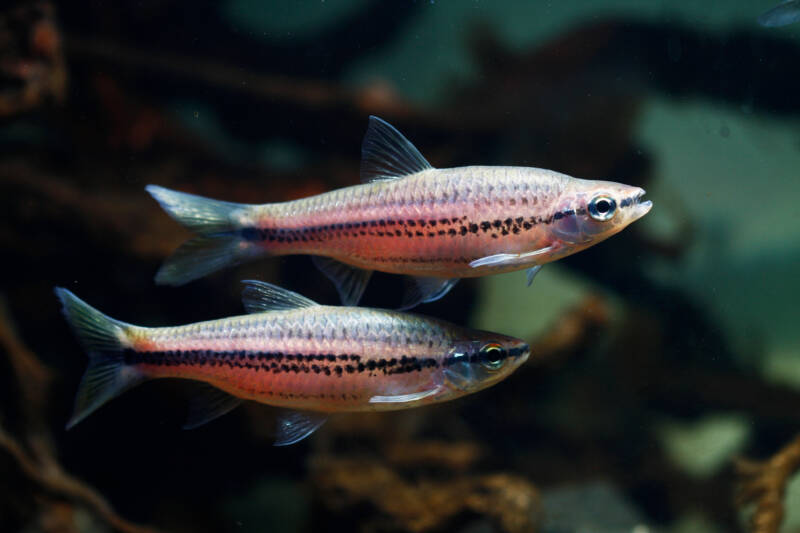
- Difficulty: Easy
- Size: 5 inches
- Temperament: Peaceful
- Diet: Omnivore
- Tank Size: 65 gal (246 l)
The porthole rasbora inhabits blackwater streams in China, Vietnam, and Laos. In a home aquarium, these fish need slow-moving waters and dim lighting. They tolerate a narrow water temperature range but a wide range of pH and hardness values.
Porthole rasboras have yellow to pink-hued bodies with wispy, dark horizontal stripes. They grow to five inches (13 cm) in length and are peaceful in nature.
This rasbora can live in a community with other mild-tempered fish. Purchase a group of at least six to promote social, shoaling behavior. Their brightest colors come out when these omnivores eat a diet rich in live and frozen meaty foods.
5. Scissortail Rasbora (Rasbora trilineata)
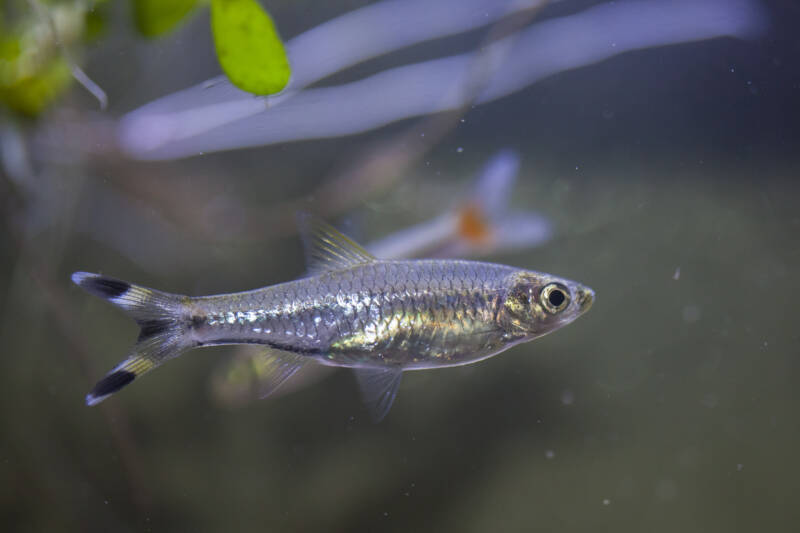
- Difficulty: Easy
- Size: 3 inches
- Temperament: Peaceful
- Diet: Carnivore
- Tank Size: 20 gal (76 l)
Scissortail rasboras take their name, not from any particular pattern or coloration, but their tails’ structure.
Their bodies are narrow and thin, and their tails have a deep fork in them, replicating a pair of scissors. You do get vibrant black and white stripes on the tail, though.
Unlike other types of rasboras, scissortails aren’t picky about your tank setup. If you’d rather skip the plants, they won’t mind. These fish want as much swimming room as possible. Just make sure you have a school of at least five.
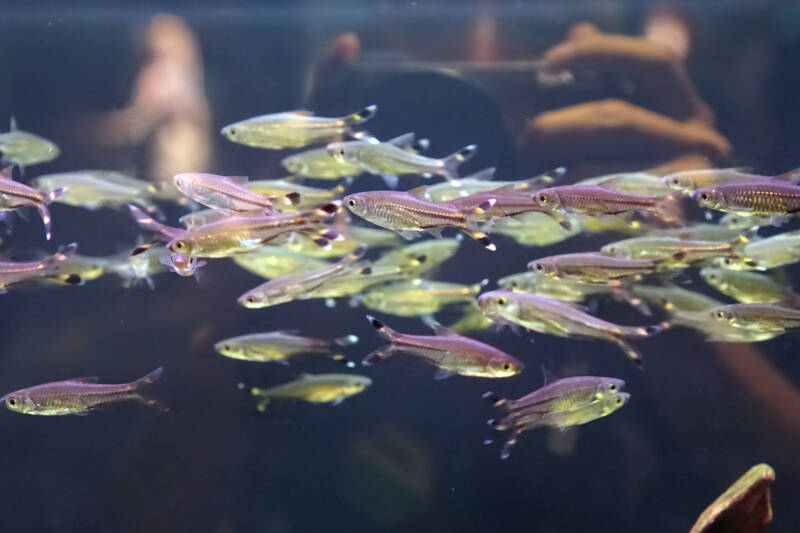
Scissortail rasboras are one of the larger types of rasboras out there. They reach an adult length of three inches (7.6 cm). When they dash around the tank, snapping those “scissors” back and forth, it makes for an impressive display.
6. Yellowtail Rasbora (Rasbora tornieri)
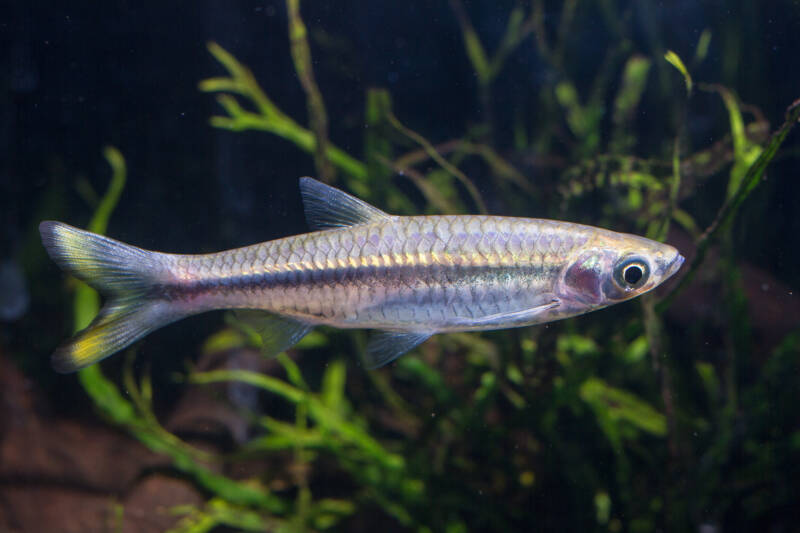
- Difficulty: Moderate
- Size: 6 inches
- Temperament: Peaceful
- Diet: Omnivore
- Tank Size: 60 gal (227 l)
Yellowtail rasboras have sleek, silver bodies with two horizontal stripes: one dark brown topped by a yellow one. Their forked yellow tail is tipped with black. These fish are excellent in a community tank if they are not housed with aggressive or overly active fish.
This is a larger rasbora, measuring close to six inches (15 cm) fully grown. Given their size, and the fact that they are comfortable in groups of at least six, these fish require a sizable tank. Use a tight-fitting lid as yellowtails can jump!
These fish cannot tolerate lapses in water maintenance and are best for those aquarists with some experience.
7. Axelrod Rasbora (Sundadanio axelrodi)
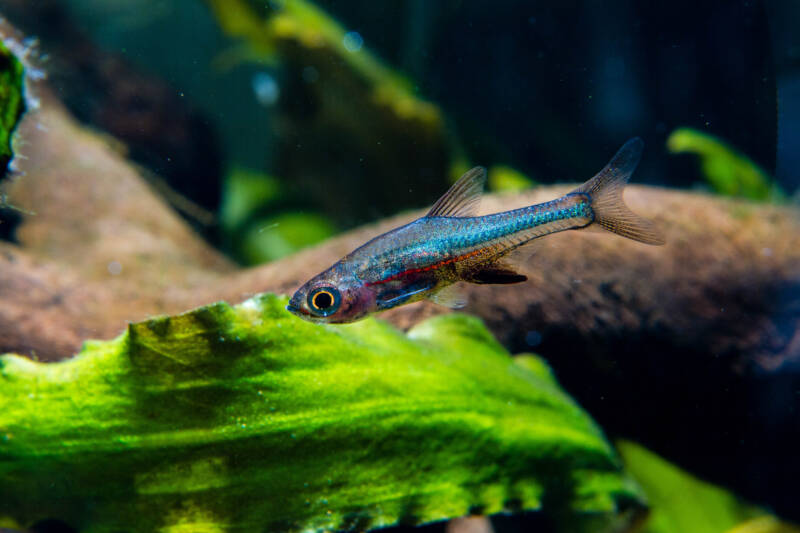
- Difficulty: Moderate
- Size: 1 inch
- Temperament: Peaceful
- Diet: Omnivore
- Tank Size: 10 gal (38 l)
Axelrod rasboras come in three color variations: blue, red, and green. The males are especially vibrant in color and make a unique croaking sound when stressed or establishing dominance.
They can be timid and do best in very large groups of 20 to 30. Therefore you will need a larger tank of at least 10 gallons.
Avoid mixing various color forms to prevent hybridization. Introduce your axelrod to a mature, well-planted tank but leave plenty of open space for swimming. Monitor water pH closely and keep it acidic between 4.0 and 6.5.
Newly acquired fish can be difficult to feed. These micro predators prefer live or frozen foods and may not accept flake food.
8. Kubotai Rasbora (Microdevario kubotai)
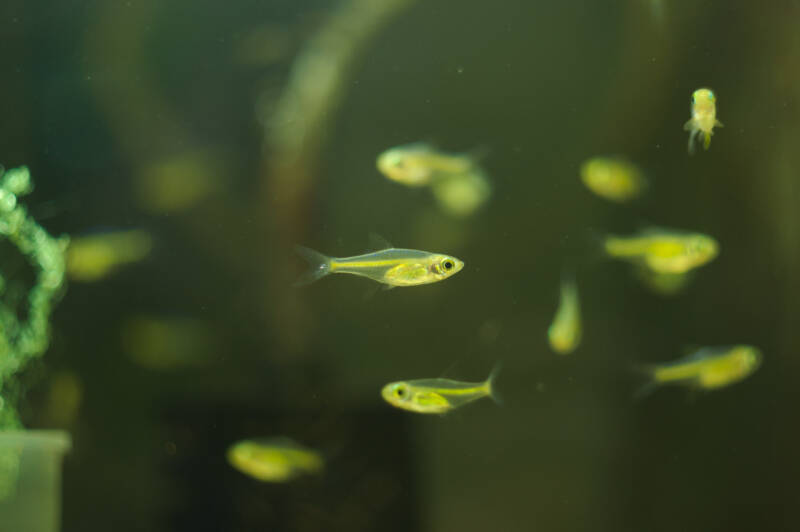
- Difficulty: Easy
- Size: 0.6 -0.8 inches
- Temperament: Peaceful
- Diet: Omnivore
- Tank Size: 5 – 10gal (38 l)
This native of Thailand inhabits slow to moderately flowing streams. In an aquarium, they need well-oxygenated, clean water along with a dark sandy substrate, driftwood, and some aquatic plants.
Their tiny adult size of 0.6 to 0.8 inches (1.5 to 2 cm) means that they need appropriately sized micro foods. It also means that they are best suited to a single species aquarium (or with other similarly sized species) as any larger tank mates may consider them food.
These fish are most comfortable in large groups. Consider a school of eight to 10 as the minimum to see the best behavior and brightest neon green colors from this fish. Therefore in a school of 8 – 10 you will need a 10 gallon tank, but could keep 4 fish in a 5 gallon tank with frequent water changes.
9. Phoenix Rasbora (Boraras merah)
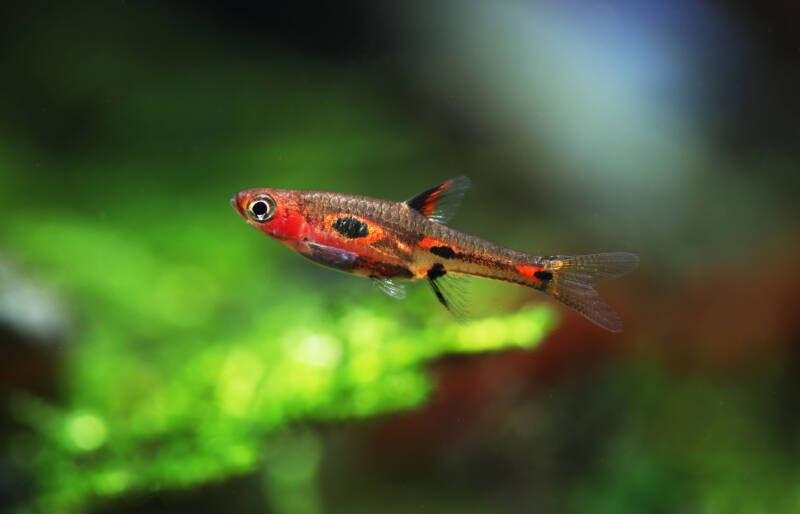
- Difficulty: Easy
- Size: 0.5 inches
- Temperament: Peaceful
- Diet: Carnivore
- Tank Size: 5 – 10 gal (38 l)
You need to take a closer look to appreciate the phoenix rasbora’s true beauty. Otherwise, they look like an ordinary red fish. It’s only close-up you can appreciate the black spots in their circles of orange, red, and yellow, harkening to the mythical bird they’re named after.
The shoaling instinct in phoenixes is STRONG. They swim in coordinated patterns, exploring your plants. It’s recommended you keep at least eight together in order to see their natural, happy behavior. Smaller groups might result in nervous behaviors and less natural swimming about the tank, but not always. If you opt for a 5 gallon tank, it is recommended to keep up to 4 fish.
Unlike other tiny types of rasboras, the phoenix rasbora does well with peaceful freshwater fish.
You can keep them with otocinclus and corydoras without a problem. You can even try them with a betta, provided it’s slow-moving.
10. Dwarf or Pygmy Rasbora (Boraras maculatus)
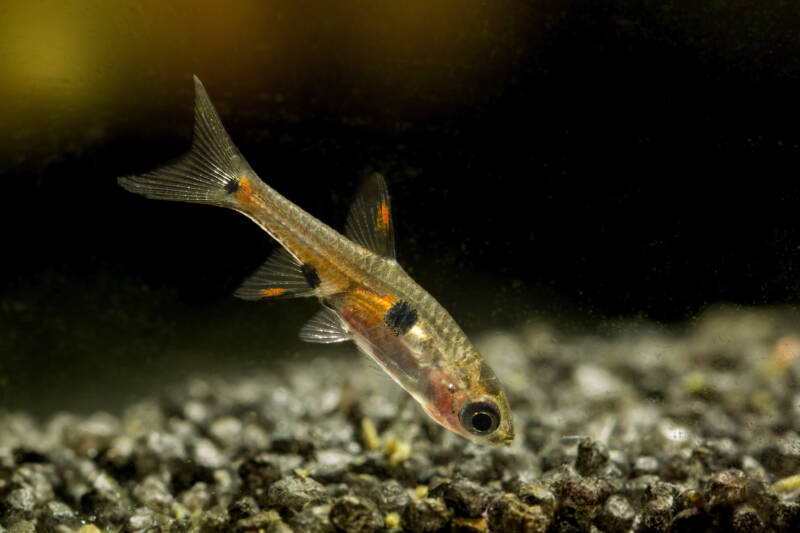
- Difficulty: Moderate
- Size: 0.8 inches
- Temperament: Peaceful
- Diet: Carnivore
- Tank Size: 5 – 10 gal (38 l)
At first glance, it’s easy to mistake dwarf rasboras for juvenile clown rasboras. After all, they have a red or pink color with three black spots. That’s the kicker, though: dwarf rasboras always have the same three spots in the same place on every fish.
Well, these reasboras are adorably TINY, playful fish. These fish barely reach one inch (2.5 cm) in size.
Dwarf Rasbora almost the smallest Cyprinid and one of the smallest fish (not to mention one of the smallest vertebrates) in the world!
They prefer staying in schools of at least twenty. It may sound excessive, but you won’t have to splurge on an enormous tank when you remember their size, but a school of twenty will need at least 10 gallons.
These rasboras do great as a community fish too, often a group of four to five fish can happily live in a 10 – 20 gallon tank with a tetra species, Furcata Rainbowfish, or a shrimp community.
Just keep your water as clean as possible. They don’t do well when water quality slips.
11. Chili Rasbora (Boraras brigittae)

- Difficulty: Easy-Moderate
- Size: 1 inch
- Temperament: Peaceful
- Diet: Carnivore
- Tank Size: 10 gal (38 l)
As you might guess from the name, chili rasboras have a brilliant red color. When seen together in a school against a planted aquarium, that vibrant red pops.
They also have a subtle blue splash in the center of their bodies that catches the light.
Chilis are one of the smallest types of rasboras. They rarely get larger than one inch (2.5 cm) in length at full growth.
While that suggests a nano aquarium, you can’t forget their shoaling nature. You’ll need a school of at least twelve, and that requires a minimum of 10 gallons (38 l).
You’ll need a little more experience under your belt to manage chili rasboras. They come from blackwater ponds naturally deficient in minerals. And you’ll need to replicate those soft, acidic waters as closely as possible. Too many unnecessary chemicals and your fish won’t make it.
12. Strawberry Rasbora (Boraras naevus)

- Difficulty: Easy
- Size: 0.7 inch
- Temperament: Peaceful
- Diet: Omnivore
- Tank Size: 5 gal (19 l)
The strawberry rasbora is a lovely red color and marked by a large black dot on its side. This is another small species, maxing out at 0.7 inches (1.8 cm) as an adult.
They prefer acidic water and tolerate a decent range of temperatures. Plan on installing a heater to keep the temperature consistent.
They are excellent nano tank fish. Keep in mind that while they need a minimum school size of five, keeping 15 or more is even better. The strawberry rasbora is an omnivore, but they need a diet heavy on the meaty side and will accept both live and frozen foods.
13. Clown Rasbora (Rasbora kalochroma)
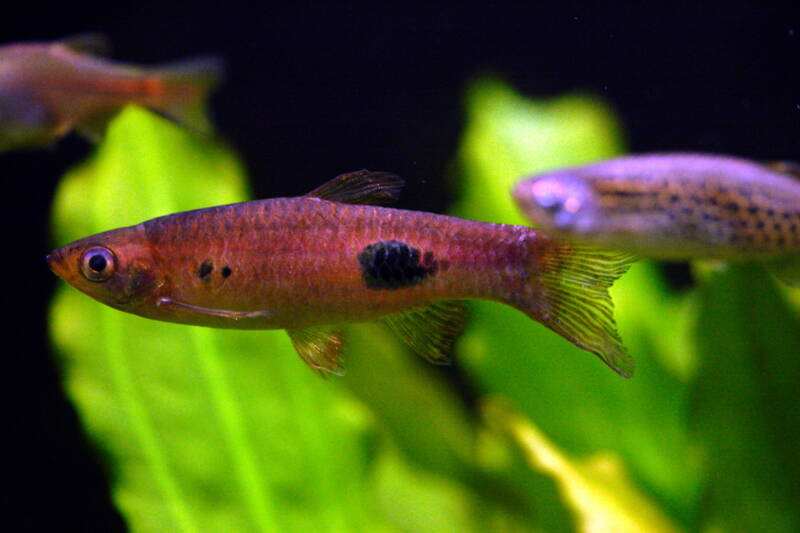
- Difficulty: Easy-Moderate
- Size: 4 inches
- Temperament: Peaceful
- Diet: Carnivore
- Tank Size: 60 gal (227 l)
Clown rasboras are one of the most unique types of rasboras. They have a base of pink to red scales on which you’ll find random black spots.
No two clown rasboras have the same pattern, making for a dramatic shifting of black and red in your aquarium.
Clowns top the ruler at four inches (10 cm). They also prefer a school of at least eight members, requiring a substantial tank to prevent excessive nerves in the group.
You’ll want a tight lid, as well, because if they get TOO frightened, they’ll launch themselves out of the tank.
Clown rasboras come from peat bogs, where there’s a heavy tannin burden. If you keep your water TOO clear, they’ll end up looking washed out. Consider adding alder cones into your HOB filter to help with the staining of your water. Then your clown rasboras will stay red.
14. Least Rasbora (Boraras urophthalmoides)
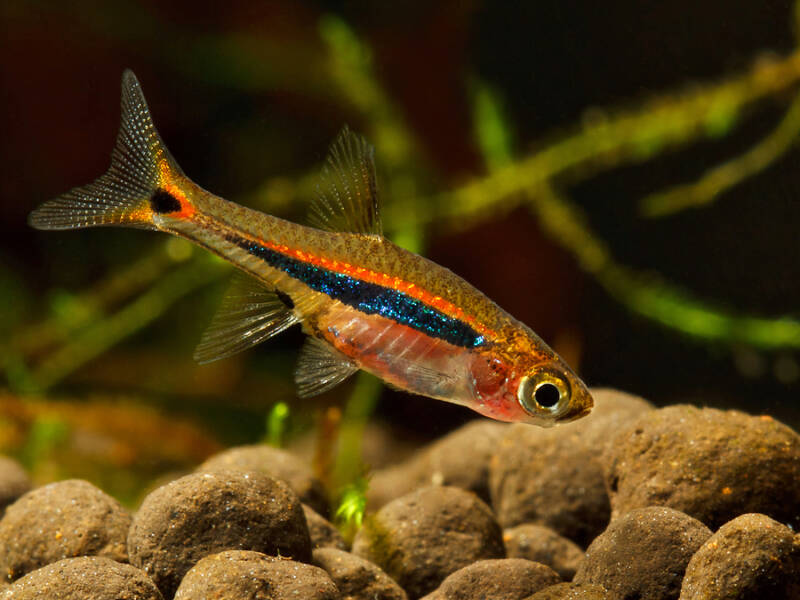
- Difficulty: Moderate
- Size: 0.6 inches
- Temperament: Peaceful
- Diet: Carnivore
- Tank Size: 10 gal (38 l)
Least rasboras come in a few different colors. All feature a broad black band down the length of the fish.
They get their name from their small size. You may also see them listed as exclamation point rasboras, a result of their black markings.
Leasts are genuinely tiny fish. At full adult length, they rarely get larger than 0.6 inches (16 mm).
This earns them the title of smallest Cyprinid, edging out the dwarf rasbora. However, males form territories, and you need a school of at least eight, and at minimum 10 gallon tank, so no nano aquariums.
In the wild, least rasboras inhabit some of the darkest waters. They don’t know what to do with bright lights. You’ll definitely want floating plants in your tank. Or you can skip aquarium lighting and leave the ambient light of the room as a substitute (if your plants allow it).
15. Harlequin Rasbora (Trigonostigma heteromorpha)

- Difficulty: Easy
- Size: 2 inches
- Temperament: Peaceful
- Diet: Carnivore
- Tank Size: 20 gal (76 l)
Harlequin rasboras provide a dramatic split between a red-orange color and black. Arguably one of the most well known rasboras in the hobby.
You may or may not notice an additional orange spot on the anal fin (scientists are still arguing whether there are two distinct species). Adults harlequins reach two inches (5 cm) in size.
If you don’t want your harlequins to succumb to stress and hide out in the plants, you need to keep a good shoal in the tank. These fish prefer a school of at least eight, so plan for a 20 gallon tank.
They stick to the middle and top of the tank, and they DON’T respond well to bullying of more aggressive fish. They can be paired with bottom dwelling fish, larger shrimp species or snails.
You can find additional color morphs for harlequin rasboras. Common variations include blue and silver. However, these varieties aren’t as hardy as the original red stock. If you go for the more exotic colors, take extra care.
16. Lambchop Rasbora (Trigonostigma espei)
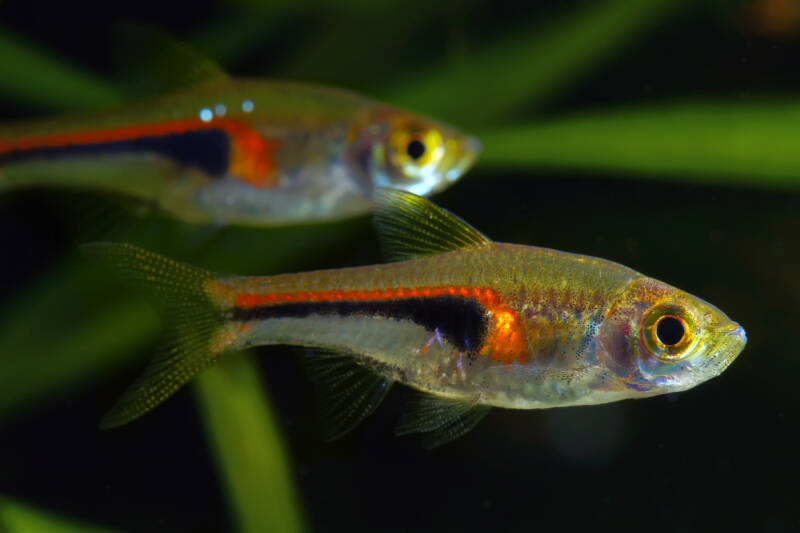
- Difficulty: Easy
- Size: 2 inches
- Temperament: Peaceful
- Diet: Carnivore
- Tank Size: 10 gal (38 l)
People often confuse lambchop rasboras with harlequin rasboras. They have similar coloration, after all.
However, lambchops have their black patch in a distinct “lambchop” orientation, rather than the full black half that you find in a harlequin.
Lambchops develop a punch of personality – provided you give them an appropriate school. These fish need a shoal of at least six to hedge off nerves. Too few members in the group and they’ll hide. If they feel comfortable, you’ll get to see them play.
Lambchops are another type of rasbora that comes from blackwater peat swamps. In the wild, they survive at acidities down to a pH range as low as 3! You won’t have to replicate that environment, but try to keep a healthy level of tannins in your aquarium.
17. Fire Rasbora (Rasboroides vaterifloris)
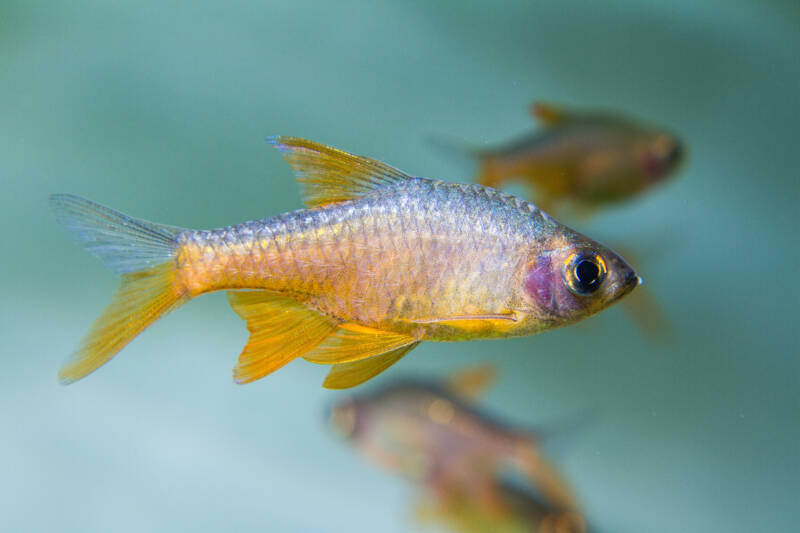
- Difficulty: Easy
- Size: 1.6 inches
- Temperament: Peaceful
- Diet: Omnivore
- Tank Size: 20 gal (76 l)
You can find fire rasboras in a range of hues, but most often they appear red, orange, or yellow. They grow to an adult length of 1.6 inches (4 cm).
Fire rasboras love to shoal in the middle to top levels of the aquarium and should be kept in a group of at least eight.
They work well in a community tank, just avoid keeping this timid species with fish that are fast feeders, are overly active, or are exceptionally large. These fish are not picky with their food but require a variety in their diet, including flake, live, and frozen foods to show their best colors.
18. Emerald Eye Rasbora (Brevibora dorsiocellata)
- Difficulty: Easy
- Size: 1.5 inches
- Temperament: Peaceful
- Diet: Omnivore
- Tank Size: 10 gal (38 l)
The emerald eye rasbora can appear in a variety of colors over a silver base with a distinctive, iridescent green eye.
These fish need a group of at least 10 to encourage confident behavior; otherwise, they can be quite shy. They are hardy, peaceful, and can live with other species that are similarly sized (around 1.5 inches (3.8 cm) in length).
Pairing your emerald eye rasbora with other species is easy when it comes to water parameters, just keep the water soft. Their natural habitat is slow-moving, heavily shaded, and vegetated blackwaters, and a home aquarium should duplicate this environment.
19. Simons Rasbora (Rasbora simonbirchi)
- Difficulty: Moderate
- Temperament: Peaceful
- Diet: Omnivore
- Tank Size: 40 gal (151 l)
Simons rasboras come from Borneo’s Barito River Basin. Their natural habitat is dimly lit, with a leaf-littered, gravel substrate and tannin-tinted waters.
Their salmon-colored bodies are accented with two prominent lines: a dark one extending from the tip of the nose through the tail topped by another, shorter shimmering green one.
Keep these fish in a group of at least six in a tank that models a flowing river. Top your tank with a tight-fitting lid as these four-inch-long (10 cm) fish can jump.
This is another species for which you must strictly maintain water conditions as they cannot tolerate any buildup of waste material.
Keeping Rasboras
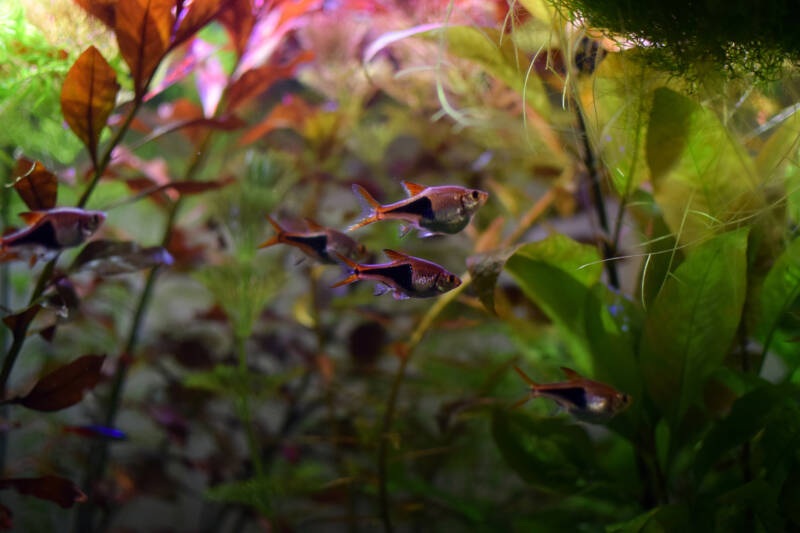
Most rasboras stay on the small side of things – no more than 1-2 inches (2.5-5 cm). You have to maintain a relatively large school, but they don’t demand enormous tanks as some cyprinids do.
Habitat
You want to mimic the rasbora’s natural habitat as closely as possible to keep them comfortable. This means maintaining a heavily planted aquarium. Leave open swimming space in the center of your tank, but create a dynamic background along the perimeter.
Optimum choices for plants include:
- Anacharis
- Anubias
- Aponogeton
- Cabomba
- Cryptocoryne
- Leptochilus.
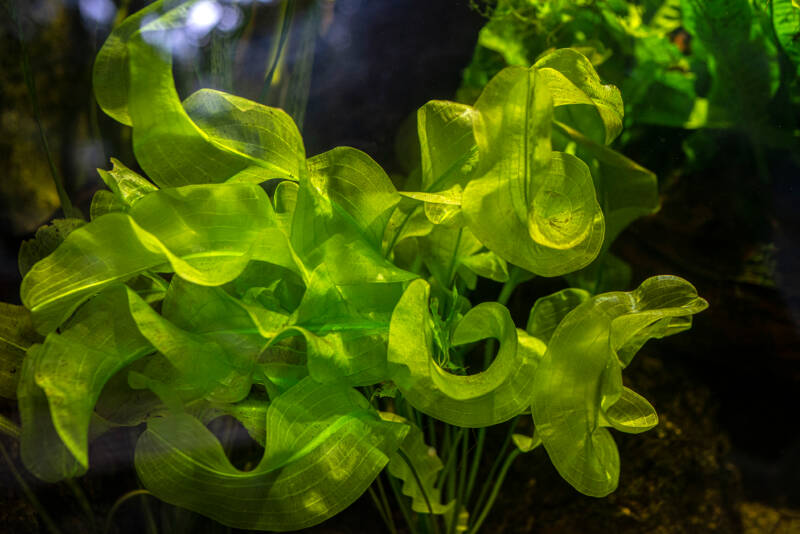
If you’re concerned about keeping the lighting dim, you can compromise by adding floating plants to your aquarium. You’ll add more greenery to enhance your rasboras’ color while also cutting down on the amount of light penetration.
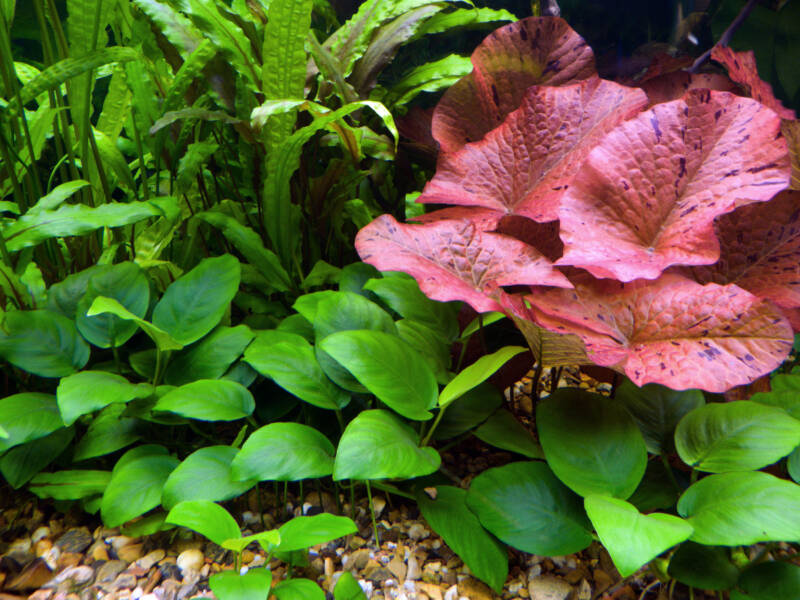
Tank Setup
In the wild, rasboras prefer shallow waters. The abundant plants lead to a high level of decay. This results in soft, acidic waters. You’ll find some types of rasboras thriving in waters around a pH as low as 4.0!
| Species | Temperature | pH | Hardness | Nitrites | Ammonia | Nitrates |
| Blackline rasbora | 72-78°F
(22-26°C) |
6.0-7.5 | 2-12dH | 0ppm | 0ppm | <25ppm |
| Brilliant rasbora | 72-79°F
(22-26°C) |
5.0-7.5 | 2-10dH | 0ppm | 0ppm | <25ppm |
| Chili rasbora | 72-82°F
(22-28°C) |
4.0-7.0 | 1-3dH | 0ppm | 0ppm | <25ppm |
| Clown rasbora | 77-82°F
(25-28°C) |
6.0-6.5 | 0-6dH | 0ppm | 0ppm | <25ppm |
| Dwarf rasbora | 74-79°F
(23-26°C) |
6.0-6.8 | 1-12dH | 0ppm | 0ppm | <25ppm |
| Harlequin rasbora | 72-77°F
(22-25°C) |
5.0-7.0 | 0-12dH | 0ppm | 0ppm | <25ppm |
| Lambchop rasbora | 73-82°F
(23-28°C) |
5.5-7.5 | 1-12dH | 0ppm | 0ppm | <25ppm |
| Mosquito rasbora | 68-82°F
(20-28°C) |
5.5-6.5 | 0-10dH | 0ppm | 0ppm | <25ppm |
| Phoenix rasbora | 68-82°F
(20-28°C) |
4.0-7.0 | 3-12dH | 0ppm | 0ppm | <25ppm |
| Scissortail rasbora | 72-77°F
(22-25°C) |
6.5-7.5 | 5-15dH | 0ppm | 0ppm | <25pmm |
Rasboras tend toward the resilient end of the spectrum.
However, they don’t tolerate sudden changes in water quality. You may see warning signs in the form of fins clamped to the sides, dropped weight, or an overall “sickly” appearance.
Tank Mates
Rasboras have peaceful natures. They get along well with other colorful freshwater fish their size. You’ll want to avoid anything with an aggressive nature, as rasboras are on the shy side. They can’t compete with cichlids.
Suitable tank mates include:
The smallest types of rasboras (those in the Boraras genus) should stick to single-species tanks due to their tiny size. However, if you’re interested in freshwater shrimp, these calm little fish make great companions for your shrimp in their nano aquarium.
Health and Disease
If you choose to go with wild-caught types of rasboras, make sure you choose healthy fish. Look for rasboras with a full-bodied appearance that readily eat offered food. Avoid sluggish fish that appear uninterested in food at all costs.
Another concern with wild-caught rasboras is the propensity for disease. Unlike captive-born fish, those shipped improperly overseas by wholesalers often develop one of the following:
- White Spot Disease: Aquarists also know this as “Ich.” Caused by the ciliate protozoan, Ichthyophthirius multifiliis, your rasboras develop white blisters all over their bodies. If left untreated, your fish CAN die.
- Velvet Disease: Velvet has two possible sources: Oödinium pilularis and Oödinium limneticum. Both are dinoflagellates that produce fine gold spots over your fish’s body. If left untreated, your rasbora can develop difficulty breathing.
You CAN treat these conditions. Quarantining your new fish for a few weeks in an isolation tank is your best bet to spot possible problems and handle medication. This will keep infection from spreading through your community.
Rasboras: The Forgotten Freshwater Fish
Science may still be struggling to place rasboras into their classification. That doesn’t mean they aren’t fantastic additions to community tanks.
Their calm natures make them perfect schooling fish to complement larger, more dramatic fish. Or you can even opt for single-species tanks and appreciate their unique character.
Do you have rasboras in your tank?Which species is your favorite?
